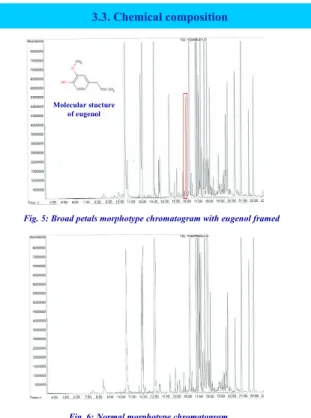Ylang-ylang (Cananga odorata (Lam.) Hook. & Thoms. var.
genuina) essential oils from Comoros Islands:
characterization and variability
Céline Benini
a, Jean-Paul Wathelet
b, Patrick du Jardin
a,
Marie-Laure Fauconnier
aa Plant Biology Unit, Gembloux Agricultural University, Gembloux, Belgium
b General and Organic Chemistry Unit,Gembloux Agricultural University, Gembloux, Belgium
.
1
.
Introduction
3. Results
4. Conclusions
The Comoros Islands constitute an archipelagocomposed of four main islands located in the Mozambique Channel, between Madagascar and the Eastern coast of Africa. These islands are divided in two political entities: Union of Comoros, independent, consisting in Grande Comore, Anjouan and Moheli and Mayotte, the second entity, a French collectivity.
Fig. 4: Ester number (A), Specific gravity (B), Optical rotation (C), Refractive index (D).
3.2. Physicochemical properties
3.3. Chemical composition
The Union of the Comoros is the world’s biggest producer of ylang-ylang essential oils, exporting forty tons of it per year. Comorian ylang-ylang also provides the most valuable essential oil that can be found on international market. This product represents a high percentage of Comoros’ annual currency .
Ylang-ylang is a tree belonging to Annonaceae familly. It grows in full or partial sun, and prefers the acidic soils of its native rainforest habitat. The leaves are long, smooth and glossy. The flower is greenish yellow, curly.
Ylang-ylang essential oil is obtained through hydrodistillation or steam distillation of the flowers and separated into different grades (extra S; extra; I; II; III) according to when the distillates are obtained which possess their own physicochemical properties .
Fig. 3: Two morphotypes of ylang-ylang studied
B
D C
A
Fig. 1: Comoros Islands
The study of essential oils extracted from both floral morphotypes of ylang-ylang (morphotype with broad petals and normal morphotype) shows that there is a very clear difference between the two chemical profiles and their respective physicochemical properties (Fig. 4). Thus, the optical rotation and the refractive index of the morphotype with broad petals are better according to AFNOR than those of the normal morphotype, the specific gravity and the ester number are worse in terms of oil general quality.
Fig. 5: Broad petals morphotype chromatogram with eugenol framed
Fig. 6: Normal morphotype chromatogram
Chemical analysis reveals that the two oils are chemically different. These dissimilarities concerned mainly geraniol, α-humulene, germacrene D in which morphotype ‘Broad petal’ is richer and benzyl acetate, l’α-farnesene and benzyl salicylate, l’α-farnesene, benzyl salycilate and cinnamyl acetate in which normal morphotype is the richest.
Generally, these chemical profiles show that the normal morphotype is richer in ester whereas the ‘Broad petals’ morphotype is richer in sesquiterpenes. But the most marked difference between the two chromatograms is the presence of eugenol (Fig. 5) in the essential oil obtained from the normal morphotype whereas it is present only at very low concentration in the other (Fig. 6).
The first results obtained showed that essential oils resulting from both floral morphotypes are chemically and statistically different, both for their physicochemical properties their chemical composition. However, it is difficult to affirm that one of these oils is qualitively better than the other following the disparity of the results observed for the physicochemical properties. Nevertheless, the presence of esters in greater quantity in the oil of the ‘normal’ morphotype tends to show that these oil would be qualitatively higher than the other. It would be interesting to continue and look further into this study by in particular separating ylang-ylang oil into different grades in order to characterize each fraction individually. There is currently a thesis that is studying the variability at an enlarge level. The experiment is carried on on four islands: Grande Comore, Madagascar, Mayotte and Nosy Bé. The polymorphism is studied at morphological, molecular and chemical levels. The final aim is to be able to clearly identify particularly good producers of the best quality essential oils. This could lead to an improvement and standardization of the production
3.1. Biological observations
2. Material and methods
Essential oils were extracted by hydrodistillation during 10 hours at 100°C (Fig. 2). In this study they were not fractionned into different grades.
The chemical characterization consists in the establishment of physicochemical properties (specific gravity, optical rotation, ester number and refractive index) following AFNOR norms and the chemical profile was establish by gaz chromatography /mass spectrometry with the following column HP5 MS and the following temperature program:
45°C (0 min) 85°C (0 min) 285°C (10 min)⇒ ⇒ 20°C/min 5°C/min
Within ylang-ylang Comorian plantations, there are several tree whose flowers presents different morphologies These trees can coexist at short distances from each others.
Two of these morphotypes were studied. The fisrt one was called ‘Broad petals’ because it has larger petals than flowers commonly found in plantations. This one also shows larger leaves and the tree is more twisted and bulkier. The other mophotype called ‘Normal’ refers to the flowers the most commonly found in plantations. Fig. 2: hydrodistillation material A B C D Références
AFNOR (2000). Recueil de normes : les huiles essentielles. Tome 1. Echantillonnage et méthodes d’analyse. AFNOR, Paris, 440 p.
AFNOR (2000). Recueil de normes : les huiles essentielles. Tome 2. Monographies relatives aux huiles essentielles (H à Y). AFNOR, Paris, 661-663
Molecular stucture of eugenol
